The amount of sleep we get is changing. Electric lighting has brought many benefits, but recent research has suggested there could be a downside: too much bright, and especially blue, light in the evening could be disrupting our ability to tune out and go to sleep, and once we do conk out, how good the quality of that sleep is.
So what did human sleep look like before electricity came along? Some clues come from a study of pre-industrial communities – often tribespeople – living in remote parts of Bolivia, Namibia or Tanzania, which found that they sleep for more or less the same amount of time as we do in industrial societies (5.7-7.2 hours), but go to bed earlier, and wake up shortly before dawn. Another recent study of rubber-tappers living in northern Brazil found that those with no electric lighting slept for around 8 hours on work days and 8.8 hours on days off, while those with electric lighting slept 7.5 hours on work days and 8.4 hours on days off But such studies have all been conducted at latitudes where the length of day and night remain fairly consistent throughout the year – they don’t necessarily tell us what natural human sleep would look like in the British Isles, northern parts of the US, or Scandinavia, say.
Another approach has been to send groups of Americans camping, which exposes them to more daylight and deprives them of night-time light. Pretty quickly they’re seen to shift towards earlier bedtimes and earlier wake times, possibly suggesting that access to bright lights, smartphones and TV screens is pushing their natural tendency to go to bed late even later. But camping isn’t normal life, and neither did our ancestors live in tents that let the light in.
To investigate how people at higher latitudes might have slept before we had electricity, Teodor Postolache and his colleagues at the University of Maryland have been studying the Old Order Amish, a religious community living in Lancaster county, Pennsylvania – which is on roughly the same latitude as New York, Madrid and Naples (or if you are in the southern hemisphere, Tasmania).
These people have made a conscious choice to remain off-grid in order to preserve a way of life they feel is closer to God. Farming still dominates their culture, but even the non-farmers spend more time outside and engaging in physical labour than most people in the west – pretty much everyone grows their own fruit and vegetables, for example. However, Amish people have many things in common with more typical Americans as well: they live in modern, insulated houses, with sprung mattresses, curtains, and hot water; they have plenty to eat (including a huge and delicious range of deserts, such as whoopee- and shoo-fly pie), and they hold down regular jobs.
One of Postolache’s most interesting findings so far is that the Old Order Amish have far lower rates of seasonal affective disorder (SAD) than other populations living at similar latitudes. In fact, the prevalence of SAD is the lowest recorded in any Caucasian population so far.
For this reason, I’ve been itching to visit this community to try and gain some insights into why this might be.
Last week, I was lucky enough to spend three nights with Hanna and Ben King and their adult children, who live in a rural area a short horse-drawn buggy’s ride away from Lancaster.
Amish house in Lancaster County
Here are a few of my observations, which I will describe at length in my book, Our Solar Bodies, published next year:
- Those Amish homes I’ve seen are large, with modern fitted kitchens and bathrooms, comfortable beds, hot running water, and window blinds. They don’t have electricity, but some now have solar panels, which they use to charge the batteries they use to run their homes. Their objection isn’t to electricity, per se, but to the trappings of modern society it brings with it, such as TV and the internet, which they feel would change and fragment their community, and nurture a less Godly existence.
- They don’t have air conditioning, which means that during the hot summer months they spend even more time outdoors (often on shady verandas) exposed to the natural light/dark cycle.
- Although Amish homes are nowhere near as bright as most American homes, they don’t spend their evenings sitting in the dark, and they don’t go to bed as soon as the sun goes down – even in winter. A large propane gas lamp is often used to light the kitchen and can usually be wheeled into the living area to provide light for reading/playing board games/entertaining guests in the evenings. Until around 10 years ago, other light sources included torches (flashlights), which they used when moving to other rooms of the house, and often a kerosene oil lamp in the bathroom.
- More recently, some Amish have begun to adopt bright, battery-powered led lamps, which they carry around with them like modern-day Wee-Willy-Winkie’s candles. My problem was I kept forgetting to bring mine with me; repeatedly finding myself in the bathroom without a light-switch, and therefore having to go back for the lamp!
- The Amish stay up after dark, but they go to bed early: typically between 9 and 9.30pm in summer, and more like 8.30-9pm in winter. Most people start work at around 5.30am, so they’re often up by 4.45am. In preliminary studies, Postolache and his colleagues have found average sleep times of 8.12 hours in summer and 7.30 hours in winter.
- Several sources have suggested that before we had electricity, people at northerly latitudes experienced biphasic sleep – basically splitting the night into two sleep phases, with a period of several hours wakefulness in the middle – particularly in winter. Postolache and colleagues have found no evidence for this in the Amish, and no-one I interviewed identified with this pattern either.
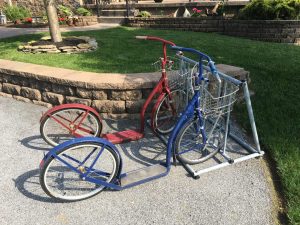 Once they’re awake, Amish people are generally up and out of the house very quickly (they don’t mess around blow-drying their hair, applying make-up, deciding what to wear, or slowly supping cups of coffee). This means they’re exposed to daylight – or at least twilight – shortly after waking. Amish people often walk to work, or ride adult-sized scooters with bicycle wheels for tyres, which – besides being great fun to ride – expose them to yet more daylight, and mean they’re getting some physical exercise first thing in the morning (exercise, food, and especially light, are all cues used by the body to synchronise its internal clocks to the external time of day).
Once they’re awake, Amish people are generally up and out of the house very quickly (they don’t mess around blow-drying their hair, applying make-up, deciding what to wear, or slowly supping cups of coffee). This means they’re exposed to daylight – or at least twilight – shortly after waking. Amish people often walk to work, or ride adult-sized scooters with bicycle wheels for tyres, which – besides being great fun to ride – expose them to yet more daylight, and mean they’re getting some physical exercise first thing in the morning (exercise, food, and especially light, are all cues used by the body to synchronise its internal clocks to the external time of day).
- Although the Amish go to bed and get up far earlier than most people in western countries, not all Amish people are happy about this. Several women I spoke to described themselves as night owls, and said they struggled with getting to sleep in the evening and waking up at the time their society expected of them. But even these self-proclaimed night-owls said that their preferred bed time would be 10-10.30pm, and that they’d like to get up at 6.30-7am – which would be considered normal, or even quite early by many westerners.
- Amish people do occasionally have lie-ins. In the parish I visited, people attend church every other Sunday, and this was their weekend off. But an Amish lie-in isn’t what many of us would regard as a lie-in. When I surfaced at 7.30am (I was still on UK time), Hanna and Ben King were already downstairs reading their bibles, and had been up since 7am. We ate breakfast at 9am.
- Just like teenagers in other Western households, Amish teenagers seem to be more owlish than their parents. Although they go to bed at the same time most nights, during Rumspringa (a period from around the age of 16 until they get married, when an individual is allowed more access to the outside world than they would otherwise be) young people might stay out late once or twice a week. In the King household, 21-year-old Mehlan (pronounced May-lan), attends the church youth group on Sunday afternoons. They spend their time playing volleyball, singing hymns, eating, and playing more volleyball, and often don’t set off home until 10-10.30pm. And on the Saturday evening I stayed with them, Mehlan went out to play mini-golf and eat pizza, and didn’t get home until 12.30am. Again, this wouldn’t be considered particularly late by most western societies, but it was amusing to witness his mum, Hanna, shouting “Mehlan, get up – its breakfast time!” at 8.45am on a Sunday, and watch him staggering sleepily down, as teenagers are prone to do the wold over.
- Amish people might have extremely low rates of winter depression, but this doesn’t mean they all love winter. During May, when I visited, their magazines were filled with comments about how great it was to feel the sun, and to see their gardens growing again. Postolache and his colleagues too, have found that the majority (77%) of the Amish people they’ve surveyed report a seasonal pattern to when they feel best, with May being the most popular month (May in Lancaster county is beautiful: akin to a perfect English summers day).
During my stay, I also had the fascinating experience of trawling around yard sales on Memorial Day weekend with Hanna, Mehlan’s mum. Even though it was Saturday, these were pretty busy from around 5.30am.
I think you can tell a lot about a family by what they’re getting rid of at a yard sale. There were heaps of toys (Amish families are typically very large), but I also saw many old-fashioned oil lamps being sold for no more than a few dollars.
Amish households are changing, and the light emitted by battery-powered lantern is far brighter than that these lamps would have emitted when lit. One theory about why the Amish are so resistant to SAD is that in part, it’s because they’re shielded from bright artificial light in the evenings. If this is true, it’s possible that winter could become a sadder time for the Amish in the future.
From left to right: Battery-powered LED lamp; Propane gas lamp (used in kitchen/living areas); Old-fashioned kerosine oil lamp

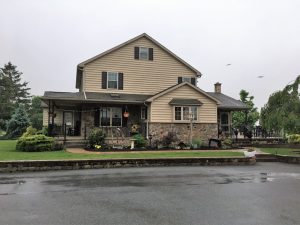
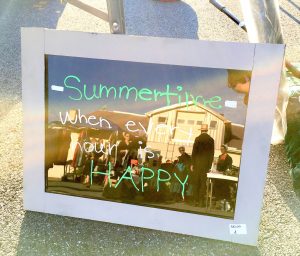
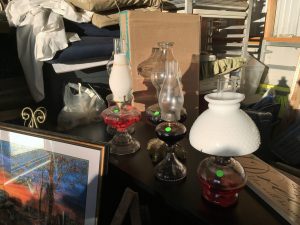
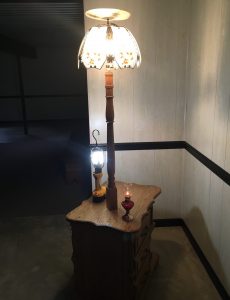
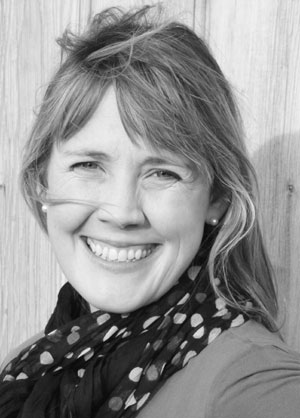
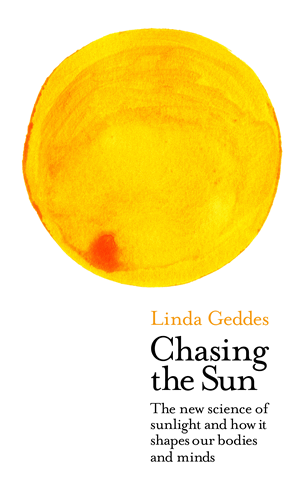

I hope that I will sleep at the Amish one time in the future. The post is very interesting. Thanks for sharing!